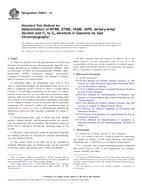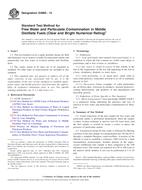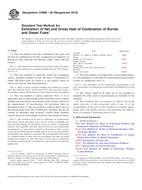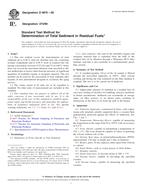We need your consent to use the individual data so that you can see information about your interests, among other things. Click "OK" to give your consent.
ASTM D7112-12
Standard Test Method for Determining Stability and Compatibility of Heavy Fuel Oils and Crude Oils by Heavy Fuel Oil Stability Analyzer (Optical Detection)
STANDARD published on 1.11.2012
The information about the standard:
Designation standards: ASTM D7112-12
Note: WITHDRAWN
Publication date standards: 1.11.2012
SKU: NS-37589
The number of pages: 11
Approximate weight : 33 g (0.07 lbs)
Country: American technical standard
Category: Technical standards ASTM
The category - similar standards:
Annotation of standard text ASTM D7112-12 :
Keywords:
asphaltene precipitation, asphaltenes, compatibility, crude oil, heavy fuel oil, insolubility number, P-value, residual oil, solubility blending number, solvent equivalent, stability, stability reserve, ICS Number Code 75.160.20 (Liquid fuels)
Additional information
| Significance and Use | ||||||||||||||
|
5.1 Automatic determination of stability parameters using a light back-scattering technique improves accuracy and removes human errors. In manual testing, operators have to visually compare oil stains on pieces of filter paper to determine if asphaltenes have been precipitated. 5.2 Refinery thermal and hydrocracking processes can be run closer to their severity limits if stability parameters can be calculated more accurately. This gives increased yield and profitability. 5.3 Results from the test method could be used to set a standard specification for stability parameters for fuel oils. 5.4 The compatibility parameters of crude oils can be used in crude oil blending in refineries to determine, in advance, which crude oil blends will be compatible and thus can be used to minimize plugging problems, unit shut downs, and maintenance costs. Determination of crude oil compatibility parameters also enables refineries to select crude oil mixtures more economically. 5.5 This test method can measure stability and compatibility parameters, and determine stability reserve on different blends for particular applications to optimize the blending, storage, and use of heavy fuel oils 1.1 This test method covers an
automated procedure involving titration and optical detection of
precipitated asphaltenes for determining the stability and
compatibility parameters of refinery residual streams, residual
fuel oils, and crude oils. Stability in this context is the ability
to maintain asphaltenes in a peptized or dissolved state and not
undergo flocculation or precipitation. Similarly, compatibility
relates to the property of mixing two or more oils without
precipitation or flocculation of asphaltenes.
1.2 This test method is applicable to residual products from atmospheric and vacuum distillation, from thermal, catalytic, and hydrocracking processes, to products typical of Specifications D396, Grades No. 5L, 5H, and 6, and D2880, Grades No. 3-GT and 4-GT, and to crude oils, providing these products contain 0.05 mass % or greater concentration of asphaltenes. 1.3 This test method is not relevant to oils that contain less than 0.05 % asphaltenes, and would be pointless to apply to unstable oils that already contain flocculated asphaltenes. 1.4 The values stated in SI units are to be regarded as standard. No other units of measurement are included in this standard. 1.5 This standard does not purport to address all of the safety concerns, if any, associated with its use. It is the responsibility of the user of this standard to establish appropriate safety and health practices and determine the applicability of regulatory limitations prior to use. |
||||||||||||||
| 2. Referenced Documents | ||||||||||||||
|
Similar standards:
Historical
1.10.2013
Historical
15.6.2013
Historical
1.5.2010
Historical
15.4.2009
Historical
15.4.2012
Historical
1.11.2012
We recommend:
Updating of laws
Do you want to be sure about the validity of used regulations?
We offer you a solution so that you could use valid and updated legislative regulations.
Would you like to get more information? Look at this page.



 ASTM D4815-13
ASTM D4815-13 ASTM D4860-13
ASTM D4860-13 ASTM D4868-00(2010)..
ASTM D4868-00(2010).. ASTM D4870-09
ASTM D4870-09 ASTM D4952-12
ASTM D4952-12 ASTM D4953-06(2012)..
ASTM D4953-06(2012)..
 Cookies
Cookies
